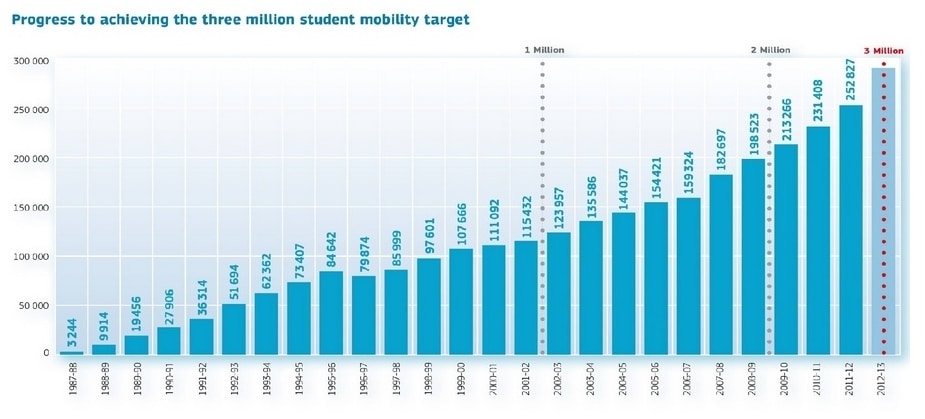EU releases strategy document urging intensified globalisation of education in Europe
The European Commission released a report and statement this month that urges EU universities and schools to ramp up the degree to which they are global, or internationalised, in order to compete effectively in the ever-intensifying battle for international student enrolments. Europe has long enjoyed a reputation for safety, beauty, and quality education amongst prospective students around the world, and in some cases its historical, language, or cultural ties (e.g., with North America, Australia, New Zealand, etc.) have also been a factor in its appeal as a study abroad choice. But the European Commission report, entitled “European higher education in the world,” asserts that Europe must not “rest on its laurels” – that it needs new strategies to maintain its relevance both from an educational standpoint and an economical one. It says:
“Europe remains an attractive destination for mobile learners with a stable share of around 45% of the internationally mobile student population, a population expected to grow from around 4 million today to 7 million by the end of the decade. Nevertheless, if European HEIs want to continue to be the number one destination against a background of increasing competition from Asia, the Middle East and Latin America, they must act strategically to capitalise on Europe’s reputation for top quality higher education.”
In order to do so, the strategy document says European education institutions will need to:
- Increase the sophistication of both their online delivery and customisation efforts;
- Actively promote international mobility of students and staff;
- Provide world-class innovative curricula as well as excellence in teaching and research opportunities;
- Enter into cooperation and strategic partnerships with other HEIs, government institutions, the private sector and civil society around the world;
- Ensure that higher education responds to labour market needs;
- Ensure that those European students who elect not to study abroad nonetheless receive a globally-oriented education at home so they can get a job anywhere in the world, via such initiatives as learning foreign languages, having access to staff with international experience, and partaking in international collaboration via online learning.
On the subject of elearning, the report notes: “New trends in digital education and the emergence of MOOCs should be an incentive for higher education institutions to rethink their cost structures and possibly also their missions, and engage in worldwide partnerships to increase the quality of content and of the learning experience through blended learning.”
Erasmus expands in the efforts to reach 4 million people
According to the European Commission's press release:
“The number of higher education students in the world is expected to quadruple, from around 100 million in 2000 to 400 million in 2030, with particularly strong growth in Asia and Latin America. The number of students going abroad rises by 7% every year (with major growth in China, India and South Korea)."
Related to this growth and the EU's drive for a more globalised education outlook, in January 2014 the EU will launch a new programme for education, training, youth, and sport known as Erasmus+ (previously under the working title of "Erasmus for all" - see our earlier post on Erasmus’ planned expansion for additional background). Erasmus+ replaces the current Lifelong Learning Programme (Erasmus, Leonardo da Vinci, Comenius, Grundtvig), as well as Youth in Action, Erasmus Mundus, Tempus, Alfa, Edulink and the bilateral cooperation programme with industrialised countries.
Erasmus+ will build on the legacy of Erasmus by offering opportunities for 4 million people to study, train, teach or volunteer abroad by 2020.
Erasmus+ will also allow for 135,000 student and staff exchanges between the EU and the rest of the world. This is 100,000 more than under the existing Erasmus Mundus programme. The new programme will benefit from a 40% budget increase with a total of approximately €14.5 billion for the 2014-2020 period. Erasmus+ will allocate more than €400 million a year to support international student exchanges and increased cooperation between European universities and their partners worldwide. Currently, around 10% of EU students study or train abroad with the support of Erasmus or other public and private means. Around 4.5% receive an Erasmus grant.
The EU target for overall student mobility is at least 20% by 2020.
Internationalisation is more than securing international student enrolments
The EU strategy document makes the point that courting international students is not, in and of itself, a sufficiently robust internationalisation strategy. It emphasises multilateral flows of students and academic linkages:
“International academic cooperation is often still fragmented, based on the initiative of individual academics or research teams, and not necessarily linked to an institutional or national strategy. Effective strategies should also include the development of international curricula, strategic partnerships, finding new ways of delivering content, and ensuring complementarity with broader national policies for external cooperation, international development, migration, trade, employment, regional development, research and innovation.”
As a result, the EU intends to support those universities and colleges that form partnerships within and outside Europe through joint projects and web-based courses, and to work with them on smoothing the way for joint and double degree programmes.
One size will not fit all
As much as the EU is urging all European higher education institutions to think more broadly and aggressively about internationalisation, it also recognises that individual institutions will need to figure out their own strategies. Androulla Vassiliou, Commissioner for Education, Culture, Multilingualism and Youth, said:
"European universities need to think global ... While many European universities have good links inside the EU, many lack a clear strategy for strengthening ties with non-European partners. This urgently needs to change. The Commission will support Member States so that they can develop their international higher education networks. There is no one-size-fits-all model for this: countries need to play to their strengths."
For a recap on recent strategies being used in different countries and institutions, please see our article “Europe takes stock of its international student strategies.”
Erasmus figures to date
Erasmus+ is launching in the wake of new data that shows that over 3 million students have benefited from EU Erasmus grants since the exchange scheme's launch in 1987.
Erasmus enables students in higher education to spend between 3 and 12 months in another European country – either for studies or for a work placement in a company or other organisation.
Any student enrolled in a participating higher education or vocational institution in one of the 33 Erasmus countries can benefit (EU Member States, Iceland, Liechtenstein, Norway, Switzerland and Turkey).
Erasmus is not just a funding scheme for student and staff exchanges: it also supports joint projects, summer schools and networks, with the aim of improving how education is delivered so that it meets the needs of the labour market and society as a whole.
New figures for the 2011/12 academic year show that it allowed an unprecedented 252,827 European students to study abroad or work with foreign companies to improve their work experience and prospects. Additionally, 46,527 staff in higher education received Erasmus funding to go abroad for studies, job placements, teaching or training. This represent a new record and annual increase of 9% compared with the previous year.

Erasmus study abroad figures
Of the 252,827 European students who went abroad in 2011/12, around 80% of them (204,744 students) opted to spend an average of 6.3 months abroad at a university or other higher education institution as part of their degree programme - this represents an increase of 7.5% on 2010/11. Some top-line statistics include:
- Spain sent out most students for studies (34,103), and remained the most popular destination, hosting 30,580 Erasmus students;
- Germany took second place by sending 27,593 students but placed third in terms of receiving (19,120);
- France sent 25,924 students and received 23,173;
- Luxembourg, Liechtenstein and Spain sent out the most students compared to the size of their student population.
- The number of students going abroad decreased in six countries (Bulgaria, Cyprus, Estonia, Iceland, Liechtenstein and Romania).
Social sciences, business studies and law were the most popular subject areas for Erasmus students (41.4%), followed by humanities and arts (21.9%), then engineering, manufacturing and construction (15.1%). The average grant was €234 (versus €226 in the previous year).
Erasmus work abroad figures
Since 2007, Erasmus has offered students the opportunity to go abroad to gain work experience in companies or other organisations. With a growth rate of 18% on the previous year, job placements continue to be increasingly popular with one-in-five Erasmus students (48,083 out of 252,827) working abroad in 2011/12. The average duration of a placement was 4.3 months, and students received an average monthly EU grant of €361 (down from €366 in 2010/11). The largest group of students on Erasmus work placements mimicked study abroad trends with 31.9% coming from social sciences, business and law background, followed by engineering, manufacturing and construction (17.1%), and humanities and arts students (16.9%). Country comparisons include:
- France held onto first place as the country sending the most students on Erasmus work placements (7,345);
- Germany was in second place (5,770), and Spain third (5,442);
- Spain was the most popular destination for Erasmus work placements, hosting 7,807 students;
- United Kingdom was in second place (7,736), and Germany third (6,655).
To support work placements abroad, a higher education institution can create a consortium for placements. These consortia comprise HE institutions and other organisations, such as companies or associations, and 93 placement consortia were funded in 12 countries (Austria, Bulgaria, Czech Republic, Finland, France, Germany, Greece, Italy, Netherlands, Poland, Portugal, and Spain). These consortia organised over 15% of all work placements abroad under Erasmus in 2011/12.
Building on current strengths
Mrs Vassiliou concluded: "Erasmus is more important than ever in times of economic hardship and high youth unemployment: the skills and international experience gained by Erasmus students make them more employable and more likely to be mobile on the labour market. Erasmus has also played a tremendous role in improving the quality of higher education in Europe by opening up our universities and colleges to international cooperation."














